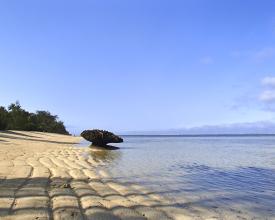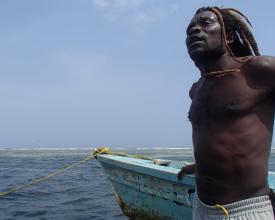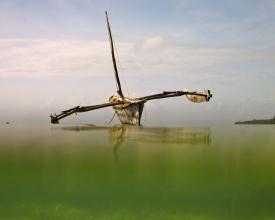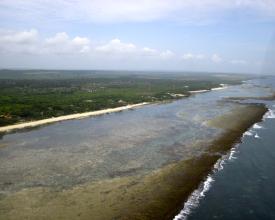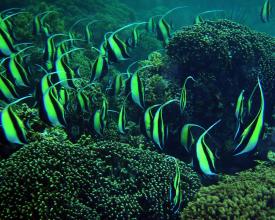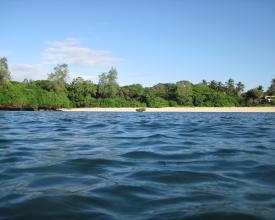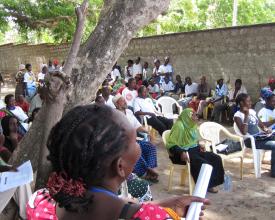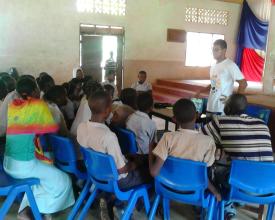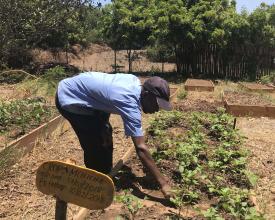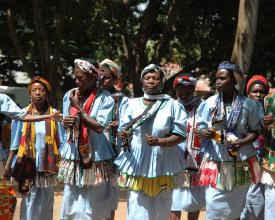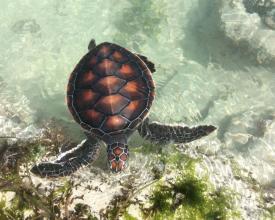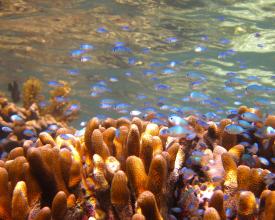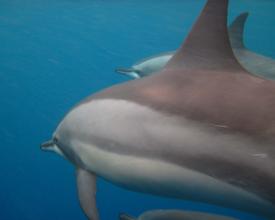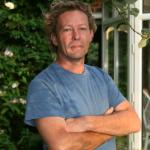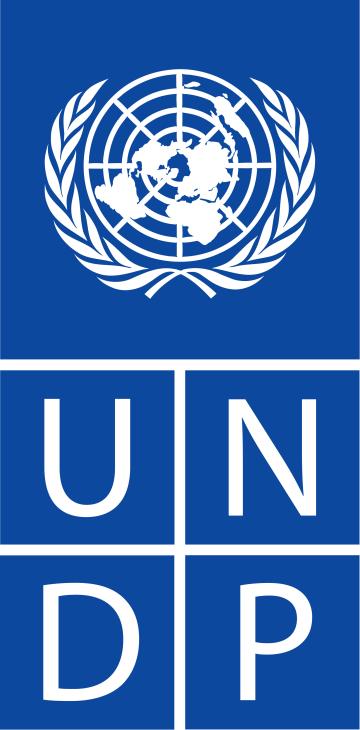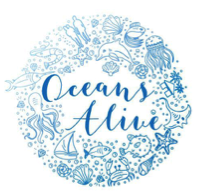
Conservation marine communautaire. Début du mouvement des aires marines gérées localement au Kenya en réponse au déclin des poissons à Kuruwitu, sur la côte nord du Kenya.

La Kuruwitu Conservation and Welfare Association (KCWA) a été créée en 2003 par des membres de la communauté préoccupés par la dégradation de leurs mers. La surpêche et les effets du changement climatique devaient être combattus avant que l'écosystème marin ne soit irrémédiablement endommagé. Les pêcheurs et les résidents concernés, qui se souvenaient de la santé et de la productivité de la mer dans le passé, ont estimé qu'il était nécessaire d'agir avant qu'il ne soit trop tard. En 2005, ils ont pris la décision sans précédent de créer une zone marine protégée (ZMP) de 30 hectares. Il s'agissait de la première zone marine gérée localement (LMMA) à base de coraux au Kenya. Douze ans plus tard, la zone s'est remarquablement reconstituée. La pêche étant interdite dans la ZMP, les poissons ont augmenté en abondance, en taille et en diversité. Les prises de poissons dans la zone se sont améliorées et des entreprises alternatives génératrices de revenus ont été introduites. Kuruwitu est devenu un modèle de conservation marine durable. Les KCWA partagent leurs connaissances avec d'autres communautés côtières locales et régionales.
Contexte
Défis à relever
Kuruwitu est principalement une communauté de pêche de subsistance qui dépend des ressources marines locales pour sa subsistance. L'augmentation de la population s'est traduite par une augmentation du nombre de pêcheurs dans la région, ce qui a entraîné une surpêche. Le désespoir a entraîné la capture de poissons plus petits, souvent à l'aide de techniques de pêche non durables. La diminution des prises a entraîné une baisse des revenus d'une communauté déjà appauvrie qui n'avait pas d'autres compétences que la pêche. Les zones de pêche ne sont plus viables et les pêcheurs ne peuvent plus nourrir leur famille, ce qui entraîne une augmentation de la criminalité. L'un des principaux défis a été d'amener la majorité des pêcheurs à s'unir et à comprendre que la fermeture leur serait bénéfique à long terme. Pour parvenir à une solution de pêche durable, il fallait s'attaquer à la question des filets illégaux. Un financement est nécessaire pour remplacer les filets et lancer d'autres entreprises. Cela s'est avéré difficile dans le cadre d'un nouveau projet qui n'a pas encore fait ses preuves. Il fallait également s'attaquer au braconnage des minorités.
Emplacement
Traiter
Résumé du processus
Bien que la mise en place d'une AMP soit compliquée et repose sur de nombreux facteurs interactifs, trois ingrédients principaux doivent être présents tout au long du processus : le cadre juridique, la gestion, l'adhésion de la communauté et les avantages qu'elle en retire. Ils sont tous liés et doivent fonctionner séparément et à l'unisson. Un cadre institutionnel avec des exigences légales et des procédures de gestion est nécessaire pour créer une base solide. Pour que la conservation fonctionne dans les zones où la pauvreté est présente, il faut qu'il y ait une composante de bien-être.
Blocs de construction
Zone marine protégée (ZMP)
La reconnaissance par la communauté de la nécessité d'agir pour améliorer les stocks de poissons en diminution a été suivie par l'identification de diverses parties prenantes pour nous aider à atteindre nos objectifs. Des programmes de communication, d'information et de sensibilisation ont été mis en place et une visite d'un projet similaire en Tanzanie a eu lieu en 2004, encourageant la communauté à utiliser les ressources marines locales de manière durable.
Une décision démocratique de fermeture d'une zone de lagune a été prise. Des cadres juridiques et politiques ont été mis en place et la première LMMA du Kenya a été approuvée en 2006 sous l'égide de l'Autorité nationale de gestion de l'environnement. Par la suite, un modèle de gouvernance collaborative a vu le jour dans le cadre des unités de gestion des plages (BMU), où les pêcheurs et le gouvernement travaillent ensemble à une pêche durable et à l'amélioration des moyens de subsistance. Lors de la mise en place de l'AMP, nous sommes passés par différentes phases : conceptualisation, création, mise en œuvre, surveillance, gestion et gestion adaptative permanente.
Facteurs favorables
La prise de conscience par la communauté de l'imminence d'une crise importante et la détermination à agir pour le bien des générations futures ont été un facteur crucial dans le processus de mise en œuvre. La confiance et la croyance en une issue positive étaient primordiales. Le financement initial des entreprises alternatives et le soutien des principaux partenaires ont été nécessaires pour les capacités techniques et consultatives. Le choix d'une zone présentant un bon potentiel de rétablissement s'est fait avec l'aide d'un scientifique qui avait déjà surveillé cette partie de la côte, ainsi que des connaissances locales.
Leçon apprise
Dès le départ, il est essentiel d'élaborer une stratégie et un plan de gestion clairs avec la participation maximale des membres de la communauté. L'écoute des anciens au sein de la communauté crée un lien essentiel entre le passé et le présent. Les cibles et les objectifs doivent être réalisables et des échéances claires doivent être fixées et respectées pour conserver le soutien de la communauté. L'ensemble de la communauté doit bénéficier du projet et les moyens de subsistance doivent s'améliorer de manière tangible afin de maintenir le soutien et de créer un sentiment d'appartenance qui confère au projet sa longévité. L'aspect social de la communauté doit faire partie de la stratégie. La sensibilisation, l'éducation et le partage d'informations doivent être maintenus, et la volonté d'adopter une approche de gestion adaptative est vitale. Apprendre de ses erreurs, partager ses connaissances et créer des alliances étroites avec d'autres organisations similaires permet au projet de progresser rapidement. La création de partenariats de collaboration et le respect de procédures claires et de lignes directrices législatives renforcent la structure de toute entité. Une bonne gouvernance dès le départ, avec une constitution claire et respectée à tout moment.
Cadre institutionnel, exigences juridiques et gestion
Depuis que la KCWA a lancé la première AMP au Kenya, la politique qui régit la reconnaissance d'une aire marine gérée localement n'était pas claire. La KCWA a fait appel à d'autres parties prenantes, comme l'East African Wildlife Society, qui l'a aidée à élaborer des cadres juridiques et à défendre sa politique. La reconnaissance de cette zone par l'Autorité nationale de gestion de l'environnement (NEMA) a garanti les droits des pêcheurs à gérer leur zone et a ouvert la voie aux 20 autres projets communautaires qui ont vu le jour à la suite du mouvement KCWA.
Cette nouvelle législation a reconnu les efforts des pêcheurs en faveur d'un modèle de gouvernance collaborative pour la gestion du territoire marin. Un plan de gestion adaptatif sur cinq ans a été élaboré à partir des connaissances locales de la zone, avec l'aide d'autres partenaires stratégiques. Les règles et la gouvernance du projet ont été définies dans un document de constitution.
Facteurs favorables
Des partenariats stratégiques originaux, à la fois juridiques et techniques, dans le cadre de ce projet pilote, ont nécessité un concept clair de ce que nous voulions réaliser et ont été essentiels pour passer le stade de la mise en œuvre. La reconnaissance par les organismes gouvernementaux compétents que le concept de gestion de leurs ressources par les communautés constituait la prochaine étape de la conservation marine a ouvert la voie à une collaboration ouverte.
Leçon apprise
Lors du lancement d'un projet pilote, il est essentiel de choisir les bons partenaires. Dans certains cas, cela s'est avéré difficile. Les programmes des partenaires différaient parfois de notre vision et devaient souvent être revus et modifiés. La légalisation et la gestion d'un nouveau concept, souvent en terrain inconnu, ont pris du temps et ont nécessité de la patience. La création d'une base juridique solide en cours de route était essentielle pour les succès futurs.
Aide sociale communautaire
Bien que l'AMP se soit rapidement rétablie et que les moyens de subsistance aient commencé à s'améliorer, une partie du plan de gestion consistait à introduire d'autres entreprises non liées à la pêche pour tenter de parvenir à une solution autonome. Dans un premier temps, il a fallu trouver des financements extérieurs pour y parvenir, et diverses subventions ont été accordées. Dans un premier temps, une entreprise touristique a attiré des visiteurs en profitant de l'amélioration du corail et de la biodiversité dans l'AMP. Cela a créé des opportunités de formation, des emplois réguliers pour les pêcheurs, améliorant ainsi leurs moyens de subsistance et réduisant la pression sur les ressources marines. Les jeunes ont été formés à la fabrication de meubles à partir de vieux boutres, du miel a été produit, du poisson pêché de manière durable a été vendu à des restaurants, des légumes et des cultures ont été cultivés et vendus, divers projets d'aquaculture sont en cours, et le groupe de femmes a diverses entreprises, notamment des ateliers de couture et une boutique d'artisanat vendant des produits fabriqués à partir de bois flotté et de savons naturels. Un système de prêt permet aux membres de financer d'autres projets. Une partie des bénéfices est affectée aux besoins de la communauté en matière d'eau, de santé et d'assainissement. Les déchets de plage sont collectés et vendus à des entreprises de recyclage. Un programme d'éducation scolaire sensibilise les enfants à l'importance de l'utilisation durable des ressources, et nous organisons des excursions dans l'AMP.
Facteurs favorables
L'AMP est au cœur de notre projet. La protection des zones de reproduction permet d'améliorer la pêche dans la région, ce qui a pour effet d'améliorer les moyens de subsistance. L'AMP est devenue une attraction et les visiteurs apportent des fonds indispensables à l'emploi, à la formation, au fonctionnement de l'organisation et à la création d'autres entreprises. Bien que nous ayons dû faire face à des défis et à des objections pour mettre de côté la zone de l'AMP, les résultats ont montré que le jeu en valait la chandelle.
Leçon apprise
Pour que la conservation soit efficace, elle doit s'accompagner d'opportunités alternatives tangibles et d'améliorations réelles des moyens de subsistance. La ressource conservée doit être précieuse et importante pour la communauté locale. Toutes les composantes doivent fonctionner à l'unisson et profiter à la communauté. Bien qu'il faille du temps, de la compréhension et de la patience pour mettre en place une LMMA, celle-ci devient un centre efficace et productif à partir duquel d'autres projets peuvent se développer. Ses avantages sont multiples et couvrent à la fois la conservation et le bien-être de la communauté. Nous avons appris en cours de route qu'il n'y a pas de raccourci pour obtenir l'adhésion de la communauté. Dans notre cas, nous travaillions avec une communauté de subsistance et même les menaces à court terme sur leurs moyens de subsistance signifiaient des difficultés directes qui conduisaient à la résistance. Nous avons appris que la plupart des résistances que nous avons rencontrées étaient sous-tendues par une crainte réelle de l'insécurité économique. Une fois que nous avons compris que les besoins de la communauté étaient primordiaux, nous avons pu élaborer des stratégies pertinentes et efficaces pour atteindre nos objectifs de conservation.
Importance de la conservation
Les scientifiques, qui surveillaient la zone avant sa fermeture, estiment que la biomasse a augmenté de 500 % dans la zone depuis la fermeture. La zone, auparavant couverte d'oursins, est aujourd'hui un haut lieu de la biodiversité, dont l'équilibre a été rétabli. Les anciens ont signalé l'apparition de nouvelles espèces dans la ZMP qui n'avaient jamais été observées de mémoire d'homme. Le corail, auparavant détruit par les pieds de l'homme, s'est rapidement rétabli et la zone du lagon est désormais connue comme l'une des meilleures destinations de plongée avec masque et tuba sur la côte kenyane. Des étudiants locaux et internationaux viennent apprendre dans notre salle de classe marine vivante. Les tortues se nourrissent des herbiers marins sans être dérangées et le nombre de nids a considérablement augmenté. La zone est passée d'un désert marin à un paradis marin et à un modèle critique à l'échelle mondiale qui montre comment une communauté pauvre peut contribuer à la conservation de la nature et en tirer profit. Des prises plus importantes et de meilleure qualité à l'extérieur de la ZMP ont permis de soutenir la fermeture permanente de la zone.
Facteurs favorables
L'AMP n'aurait pas pu voir le jour sans la conviction et la clairvoyance des pêcheurs de la région et sans l'acceptation de croire qu'un changement positif était possible, même dans des circonstances difficiles. Les connaissances locales des anciens ont permis de choisir un site approprié pour la fermeture. La recherche scientifique a également confirmé que ce choix était celui qui offrait le meilleur potentiel d'amélioration à long terme. Des mises à jour régulières sur les améliorations apportées à la ZMP ont contribué à renforcer la conviction qu'il s'agit d'une zone de reproduction réussie.
Leçon apprise
La nature est résiliente et peut se rétablir étonnamment vite si on la laisse faire. L'identification des besoins et la volonté d'accepter le changement peuvent améliorer les moyens de subsistance. L'importance d'entreprendre une évaluation de l'impact environnemental sur la zone, étayée par la recherche et les connaissances locales, avant le début du projet, a été un facteur essentiel de la réussite de l'AMP. Une sensibilisation constante et des mises à jour sur l'amélioration de l'AMP doivent être communiquées à la communauté. L'analyse des informations peut être utilisée pour mettre en perspective l'impact socio-économique. L'importance de la communication de nos progrès à la communauté est quelque chose que nous avons dû améliorer. Lorsque la communauté comprend et voit les avantages d'un changement, elle est naturellement plus disposée à l'accepter.
Impacts
Le développement d'initiatives durables ne reposant pas sur la pêche a permis de réduire la dépendance à l'égard de la pêche de subsistance et d'alléger la pression exercée sur les zones de pêche. Les stocks de poissons se sont considérablement améliorés dans l'aire marine protégée et un rapport indépendant fait état d'une augmentation considérable de la biomasse des poissons et de la biodiversité de l'ensemble de la vie marine dans la zone. Cela a permis d'augmenter les prises de poissons dans les zones de pêche voisines, améliorant ainsi les moyens de subsistance. Les tortues et les nids de la zone sont protégés par un système de compensation communautaire. Des communautés de la côte et d'autres pays voisins visitent Kuruwitu pour voir notre salle de classe vivante. Au moins 20 autres projets similaires ont été lancés par d'autres communautés côtières inspirées par KCWA. KCWA a démontré l'importance de l'implication des communautés dans les plans de gestion des ressources naturelles ; un principe qui a influencé un changement de politique de l'État vers les communautés locales. Kuruwitu a été choisi pour piloter une initiative de cogestion en collaboration avec diverses parties prenantes, couvrant une zone d'environ 100 kilomètres carrés. Il s'agit de l'un des premiers programmes de gestion concertée de ce type sur la côte kenyane, qui créera un précédent à l'avenir.
Bénéficiaires
L'amélioration des prises a profité à la communauté des pêcheurs et les moyens de subsistance se sont améliorés. La KCWA a engagé les jeunes dans des activités rémunératrices et des formations non liées à la mer. Un groupe de femmes a été créé et un programme d'éducation maritime a été mis en place pour les enfants de la région.
Objectifs de développement durable
Histoire
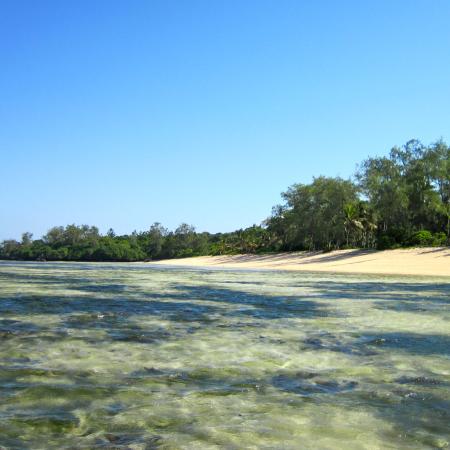
Le long de la côte kenyane, les communautés commencent à réfléchir différemment aux ressources marines dont elles dépendent. Une nouvelle génération de pêcheurs cherche des moyens de gérer leurs ressources de manière responsable afin de garantir non seulement leur propre avenir, mais aussi celui des autres. Pendant des générations, les pêcheurs de la côte kenyane ont réussi à mettre de la nourriture sur la table et à tirer leur subsistance de la pêche. Cependant, il est arrivé un moment où la taille des poissons et le nombre de prises ont commencé à diminuer au point qu'ils ne pouvaient plus vivre de cette manière. En très peu de temps, les pêcheurs ont été confrontés à l'effondrement du seul moyen de subsistance qu'ils connaissaient. Cette crise à évolution lente a attiré l'attention sur un examen plus approfondi des problèmes affectant ce qui était, et dans la plupart des cas, ce qui n'était pas débarqué dans leurs filets. Nous n'avons jamais remis en question notre mode de vie. Nos pères et nos grands-pères étaient pêcheurs et, dans notre village, c'était la seule voie que nous connaissions. Lorsque nos filets ont commencé à tomber en panne, nous nous sommes retrouvés face à un avenir inconnu". Dickson Juma, pêcheur. Le principal facteur identifié est la surpopulation de la région, qui a conduit à la surpêche. Un organisme communautaire, la Kuruwitu Conservation and Welfare Association (KCWA), a été créé pour veiller à ce que la communauté ait son mot à dire dans la gestion des ressources dont elle dépend. Avec l'aide de partenaires stratégiques, des cadres institutionnels et des structures juridiques ont été mis en place. Après une consultation approfondie, l'association a voté en 2006 la fermeture d'une partie de la zone lagunaire pour en faire une aire marine protégée. Le rajeunissement des stocks de poissons dans la zone a été rapidement visible et les prises des pêcheurs dans les environs ont commencé à augmenter. Le soutien financier a aidé la KCWA à mettre en place des entreprises alternatives correspondantes génératrices de revenus, à former les pêcheurs et leurs familles à d'autres métiers et à créer des emplois, ce qui a permis de réduire la pression sur le fragile environnement marin. Quinze ans plus tard, le filet de visiteurs est devenu un flux modeste mais régulier qui est heureux de payer pour faire de la plongée en apnée dans une zone marine protégée saine et dynamique. En 2017, la KCWA a été l'heureuse lauréate du prix Équateur du PNUD, qui récompense les efforts exceptionnels déployés par les communautés pour réduire la pauvreté grâce à la conservation et à l'utilisation durable de la biodiversité. La reconnaissance du travail acharné et des sacrifices de la communauté pour un objectif commun plus large a été une étape importante dans le développement du projet.



